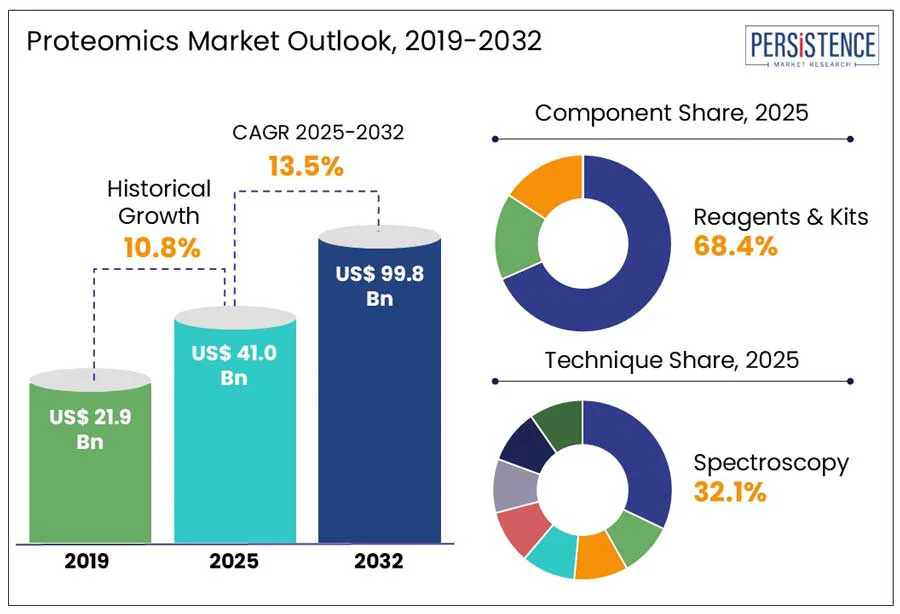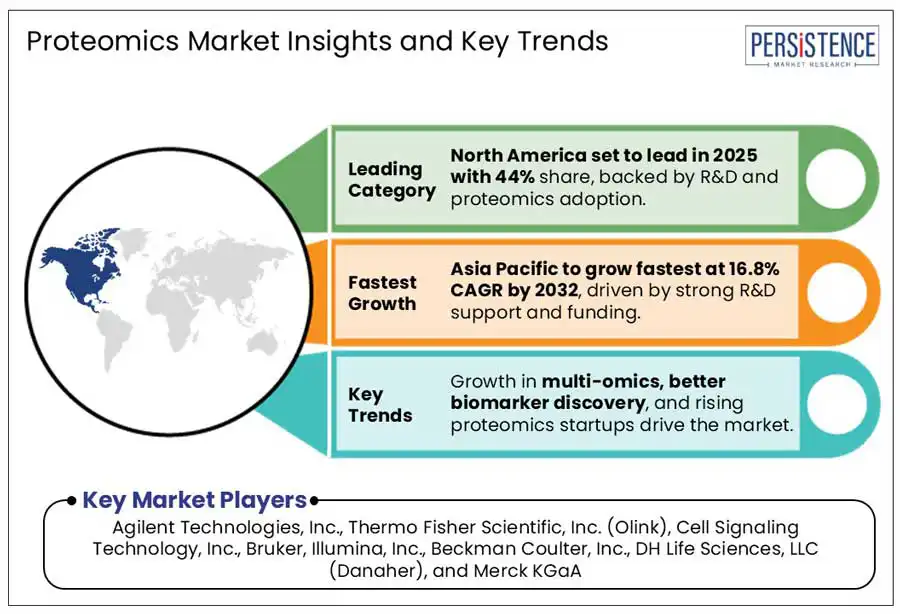ID: PMRREP31378| 247 Pages | 31 May 2025 | Format: PDF, Excel, PPT* | Healthcare

According to Persistence Market Research, the global proteomics market size is expected to account for US$ 41.0 Bn by 2025. The global market is estimated to surge ahead at a CAGR of 13.6% to reach a valuation of US$ 99.8 Bn by 2032.
Growing advancements in proteomic technology, increasing research fundings, collaborations between academic institutions and biopharma companies and rising demand for personalized therapies are the key factors driving the global proteomics market. Additionally, the growing focus on precision medicine and biomarker discovery is enhancing proteomics' role in clinical applications.
Asia Pacific is witnessing a huge expansion, supported by increasing investments and strategic partnerships. With continuous innovation, the proteomics market is expected to see a substantial increase in demand for both research and clinical applications.

Key Highlights
|
Global Market Attribute |
Key Insights |
|
Proteomics Market Size (2025E) |
US$ 41.0 Bn |
|
Market Value Forecast (2032F) |
US$ 99.8 Bn |
|
Projected Growth (CAGR 2025 to 2032) |
13.6% |
|
Historical Market Growth (CAGR 2019 to 2024) |
10.8% |
The proteomics market is experiencing strong growth driven by rising R&D activity, increasing interest in personalized medicine, and expanding use in diagnostics. Government-backed research, academic funding, and commercial investments are accelerating proteomic tool development and protein-based discovery platforms. Key technologies such as mass spectrometry and advanced separation methods are enabling deeper, more precise proteome analysis.
Additionally, startups are playing a major role in shaping the competitive landscape. For example, Alamar Biosciences raised $128M in March 2024 to commercialize an ultra-sensitive proteomics platform. Meanwhile, Syncell closed a US$15M Series A round in December 2024 to scale its Microscoop® platform. Pluto Bio secured US$3.6M in May 2025 to advance an AI-driven multi-omics tool. Age Labs, in collaboration with Lipum, obtained €1.9M for a proteomics-powered rheumatoid arthritis diagnostic in May 2025. These developments underscore how strategic funding, innovation, and a thriving startup ecosystem are collectively driving proteomics forward.
The global proteomics market faces several challenges including high cost of advanced technologies, complexity of proteomics data analysis and regulatory and ethical challenges. Instruments such as mass spectrometers and chromatography systems require substantial capital investment along with ongoing expenses for reagents and specialized personnel. This financial burden limits accessibility for many research institutions, particularly in developing regions.
Additionally, proteomic studies generate vast amounts of data that necessitate sophisticated bioinformatics tools and expertise for interpretation. The lack of standardized protocols and the need for skilled bioinformaticians hinder the effective analysis and integration of this data, slowing down research progress.
Furthermore, regulatory and ethical barriers slow clinical translation, due to limited standardization in protocols, comprehensive regulatory frameworks, uncertainty in approvals, and concerns around patient data privacy and consent. These combined challenges limit broader adoption of proteomic technologies in biomedical research and clinical applications despite strong market potential.
The proteomics market presents significant opportunities driven by technological innovations, strategic collaborations, and new product launches. Nomic Bio launched the Omni 1000 in May 2025, offering a cost-effective, high-plex solution for delivering clinically relevant data at a competitive price. Similarly, Quantum-Si expanded its partnership with SkyWater Technology in November 2024 to develop the Proteus™ platform, revolutionizing protein sequencing with enhanced scalability.
In October 2024, SCIEX introduced the ZenoTOF 7600+, advancing proteome quantification and forming key partnerships with Evosep, IonOpticks, and Bioinformatics Solutions Inc. to strengthen proteomics capabilities. Additionally, Perseus Proteomics signed an agreement with UBE Corporation to develop antibody-drug conjugates (ADCs) in October 2024. These collaborations and product advancements signal growing potential for innovation and breakthroughs in disease diagnostics, personalized medicine, and therapeutic development within the proteomics field.
Reagents & Kits are expected to dominate the global proteomic market with a revenue share of 68.4% in 2025. Kits and reagents are extensively used in proteomic processes such as protein identification, quantification, and post-translational modification studies. Their demand is increasing across various applications, including drug discovery and development, biomarker discovery, and clinical diagnostics. Growing advancements in proteomic technologies, along with increasing research activities, are driving demand for specialized reagents and kits.
The spectroscopy segment is expected to be the dominating segment with a 32.1% value share in 2025 due to its high sensitivity, speed, and versatility. Spectroscopy techniques such as mass spectrometry and Nuclear Magnetic Resonance (NMR) spectroscopy enable detailed protein profiling, structural analysis, and detection of protein interactions, making them indispensable in proteomics research.
Spectroscopy methods provide high-throughput and detailed profiling compared to other techniques such as protein microarray, X-ray crystallography, or chromatography. These techniques are valuable in proteomics but have limitations in speed, scalability, or the types of analyses they can perform. This makes spectroscopy the dominant choice in the proteomics market.
The drug discovery & development segment is expected to dominate the proteomics market with 47.8% value share in 2025. Proteomics is increasingly being utilized across the biopharma and research sectors to understand disease mechanisms and identify therapeutic targets. It enables biomarker identification, predicts drug efficiency, and assesses a drug candidate’s impact on protein expression and function, thereby playing a crucial role in drug discovery. Additionally, the growing demand for precision medicine further boosts the significance of proteomics in tailoring personalised therapies.

North America is projected to dominate the global proteomics market in 2025 with a 44.7% value share. The growth in omics research, the desire for high-quality research equipment for data reproducibility, and the focus on the development of individualized treatments are factors contributing to North America’s dominance. Strong research infrastructure, high research and development investments in protein science, and early adoption of advanced proteomic technologies further boost the market’s growth.
Several government-backed and university-led research initiatives in the U.S. as well as strategic advancements by leading biopharma companies create a highly supportive environment for proteomics innovation and application, driving advancements from basic research to clinical translation.
In January 2024, Biognosys expanded its new proteomics CRO facility in Massachusetts, U.S., aiming to accelerate therapeutic discoveries and development in the U.S. and enhance its proximity to U.S. biopharma clients. Bruker, in March 2024, unveiled major advancements in CCS-enabled 4D proteomics, including TwinScape and glyco-PASEF, enhancing data accuracy and throughput, at the 20th US Human Proteome Organization Congress.
Furthermore, in June 2024, researchers at the University of Delaware introduced a low-cost, accessible sample prep method (E3), broadening proteomics use in precision medicine. These developments reflect the maturity and innovation-led growth of the U.S. proteomics market, which continues to lead global adoption.
Europe is likely to account for nearly 24% of the proteomic market globally in 2025 driven by increased funding for precision medicine, strong academic networks, and growing public-private partnerships.
The Uk is at the forefront, with major initiatives such as the MANIFEST (Multiomic Analysis of Immunotherapy Features Evidencing Success and Toxicity) program- led by the Francis Crick Institute and The Royal Marsden NHS Foundation Trust and funded by the UK Office of Life Sciences (OLS) and the Medical Research Council (MRC) - aimed at advancing cancer immunotherapy research through multi-omic profiling of patient tissues.
Similarly, Illumina Inc. launched a pilot proteomics program, in January 2025, in collaboration with deCODE Genetics, GSK, Johnson & Johnson, Standard BioTools, Tecan, and Novartis to analyze 50,000 UK Biobank samples. In May 2025, a £1 billion London Cancer Hub was revealed, aimed at accelerating cancer research and biotech innovation, with advanced proteomics capabilities to support translational medicine and personalized treatment development.
Meanwhile, University College London (UCL) continues to lead innovation with its Proteomics Research Translational Technology Platform, supporting cancer research. The UK proteomics market leads in clinical applications and large-scale data integration, with significant advancements in precision medicine and cancer research. Meanwhile, Germany proteomics market remains strong in proteomics R&D, particularly in academic-industry collaborations, driving innovations in drug development and biomarker discovery.
Asia Pacific is projected to be highly lucrative for the manufacturers of proteomic products. Proteomics market growth in Asia Pacific countries is anticipated to be driven by rising government initiatives to support research and development in genomics, bioinformatics, and proteomics during the forecast period.
China's proteomics market is seeing significant advancements as highlighted in the 2024 HUPO Human Proteome Project, with the launch of the π-HuB (Proteomic Navigator of the Human Body) initiative. This initiative was aimed at revolutionizing human biology and disease management through advanced proteomic and computational technologies. The initiative has already secured grants for 24 projects and continues to seek international collaborations.
Similarly, India proteomics market is advancing, with the launch of its first timsTOF 4D-Proteomics facility at IIT Bombay’s Proteomica International. This facility supports high-throughput, real-time protein analysis for applications in cancer diagnostics and personalized medicine. The launch positions India at the forefront of global omics.
In April 2025, Syncell, a Taiwanese life sciences company, expanded its network with service partners in Japan, Korea, and China, including installing Microscoop® technology at China's National Center for Protein Sciences. These developments highlight the growing proteomics capabilities and collaborations across the region.
The proteomics market is witnessing intense competition, with companies such as Nomic Bio, Pluto Bio, and SCIEX advancing innovative technologies, such as high-plex solutions, AI-powered multi-omics platforms, and enhanced proteome quantification systems. Partnerships, strategic funding, and collaborations, such as those by Quantum-Si and The Human Protein Atlas, are further driving growth and innovation in precision medicine.
The global market is set to reach US$ 41.0 Bn in 2025.
The market is projected to record a CAGR of 13.6% during the forecast period from 2025 to 2032.
Increasing demand for personalized medicine, biomarker discovery, and the growing need for early disease diagnosis and targeted therapies is expected to drive the global market.
Agilent Technologies, Inc., Thermo Fisher Scientific, Inc. (Olink), Cell Signaling Technology, Inc., Bruker, Illumina, Inc., Beckman Coulter, Inc., DH Life Sciences, LLC (Danaher), and Merck KGaA are a few leading players.
North America is projected to dominate the global market in 2025.
|
Report Attributes |
Details |
|
Historical Data/Actuals |
2019 - 2024 |
|
Forecast Period |
2025 - 2032 |
|
Market Analysis Units |
Value: US$ Mn/Bn Volume: Units |
|
Geographical Coverage |
|
|
Segmental Coverage |
|
|
Competitive Analysis |
|
|
Report Highlights |
|
|
Customization and Pricing |
Available upon request |
By Component
By Technique
By Application
By End-user
By Region:
Delivery Timelines
For more information on this report and its delivery timelines please get in touch with our sales team.
About Author